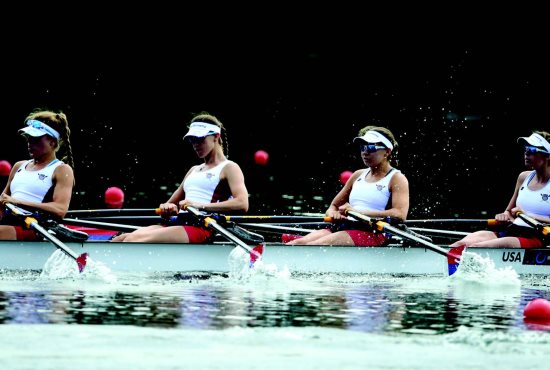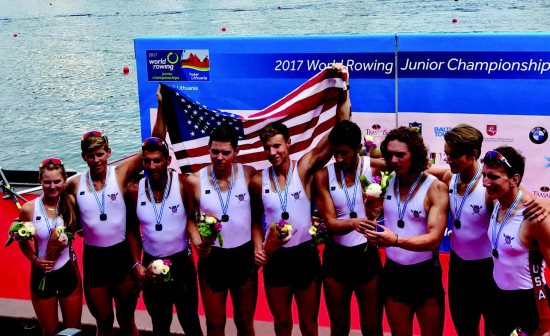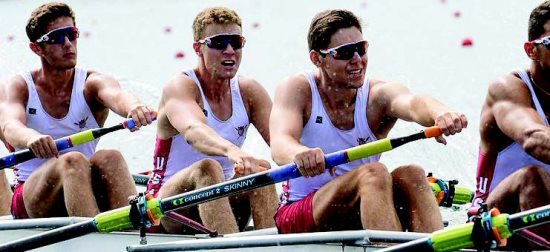 | | | Photo taken at the World Championships in the semifinals of the women's quadruple sculls. Third from left: Kate Miles Photos provided | | | | | | Oakland Strokes members Kate Miles, a Campolindo High School senior, and Nikita Lilichenko, a recent Miramonte High School graduate and incoming Stanford freshman, made the 2017 Under 19 US Rowing National Team and competed in the World Rowing Junior Championships Aug. 2-6 in Trakai, Lithuania.
 Miles did not begin rowing until her sophomore year and Nikita began as a freshman. Eight of Miles' Campo classmates also participate at Oakland Strokes.
Miles did not begin rowing until her sophomore year and Nikita began as a freshman. Eight of Miles' Campo classmates also participate at Oakland Strokes.
 Both rowers were inspired to start the sport by family members: Miles' mother rowed in college and Nikita's older brother was a competitive rower.
Both rowers were inspired to start the sport by family members: Miles' mother rowed in college and Nikita's older brother was a competitive rower.
 "I participated in the Learn to Row summer camp for a one week session and I really fell in love with the sport," said Nikita, who added, "You don't have to start at a young age to be successful. If you are committed to it, you can begin to show results immediately."
"I participated in the Learn to Row summer camp for a one week session and I really fell in love with the sport," said Nikita, who added, "You don't have to start at a young age to be successful. If you are committed to it, you can begin to show results immediately."
 Miles learned early that you get out what you put into it. "There are no short cuts. You can't cheat." The satisfaction she found was "knowing you put in the effort necessary to be successful. There is a lot of working out and practice on your own but it is the team effort that is necessary to make everything happen. We win and lose together. Your boat is only as fast as your slowest rower. I always found new challenges to face on the water and it really held my interest."
Miles learned early that you get out what you put into it. "There are no short cuts. You can't cheat." The satisfaction she found was "knowing you put in the effort necessary to be successful. There is a lot of working out and practice on your own but it is the team effort that is necessary to make everything happen. We win and lose together. Your boat is only as fast as your slowest rower. I always found new challenges to face on the water and it really held my interest."
 Managing Director of Oakland Strokes, Dana Hooper said, "The sport rewards hard work more than any other sport I've seen. Rowing as a sport is the most direct relationship with how hard you worked and how you ranked in the sport. Every rower learns that it is the ultimate team sport with 2, 4 or 8 rowers in a boat. You can show up with an ego but you will learn quickly to work as a team." There are single scull boats for those who want to row individually.
Managing Director of Oakland Strokes, Dana Hooper said, "The sport rewards hard work more than any other sport I've seen. Rowing as a sport is the most direct relationship with how hard you worked and how you ranked in the sport. Every rower learns that it is the ultimate team sport with 2, 4 or 8 rowers in a boat. You can show up with an ego but you will learn quickly to work as a team." There are single scull boats for those who want to row individually.
 The racing seasons are in the fall and the spring with training between these seasons. As members of the National Team, it became a year-round training routine for Miles and Nikita.
The racing seasons are in the fall and the spring with training between these seasons. As members of the National Team, it became a year-round training routine for Miles and Nikita.
 Oakland Strokes coach Allison Ray saw the potential in Miles quickly: "It was clear early on that Kate was special. She had the physiological tools to be a top rower - she is (5 feet 11 inches) tall with long arms and legs, which make her set up to be a good rower. She is also very athletic having a strong history in basketball and swimming. I couldn't wait for her to get to the varsity team. She is wired to be a competitive athlete."
Oakland Strokes coach Allison Ray saw the potential in Miles quickly: "It was clear early on that Kate was special. She had the physiological tools to be a top rower - she is (5 feet 11 inches) tall with long arms and legs, which make her set up to be a good rower. She is also very athletic having a strong history in basketball and swimming. I couldn't wait for her to get to the varsity team. She is wired to be a competitive athlete."
 Brian De Regt, Nikita's coach at Oakland Strokes, said, "It did not take long for him to develop. Nikita has the frame (6 foot five inches) to be able to produce the power output. Physiologically he is world class. He has the ability to push himself when it is uncomfortable."
Brian De Regt, Nikita's coach at Oakland Strokes, said, "It did not take long for him to develop. Nikita has the frame (6 foot five inches) to be able to produce the power output. Physiologically he is world class. He has the ability to push himself when it is uncomfortable."
 Hooper says handling the discomfort is the hardest trick. "You don't talk about the pain. The most successful rowers learn how to manage it."
Hooper says handling the discomfort is the hardest trick. "You don't talk about the pain. The most successful rowers learn how to manage it."
 The key to De Regt is to get "an understanding of how to work with the water. It's not complicated. You can learn 90 percent of the proper technique in the first week but it may take 10 years to learn the finest points."
The key to De Regt is to get "an understanding of how to work with the water. It's not complicated. You can learn 90 percent of the proper technique in the first week but it may take 10 years to learn the finest points."
 Nikita attributes his improvement in technique to De Regt and to Jesse Foglia, an assistant coach at Harvard who was his coach with the national team.
Nikita attributes his improvement in technique to De Regt and to Jesse Foglia, an assistant coach at Harvard who was his coach with the national team.
 Being invited to try out for the Junior National Team was just the first step. Making the team was even more difficult. Miles saw it as a real challenge: "It was very competitive because everyone there was very talented and athletic." She was chosen to row in the quadruple sculls, a four-person boat with each of the rowers handling two oars, ultimately finishing in fifth place.
Being invited to try out for the Junior National Team was just the first step. Making the team was even more difficult. Miles saw it as a real challenge: "It was very competitive because everyone there was very talented and athletic." She was chosen to row in the quadruple sculls, a four-person boat with each of the rowers handling two oars, ultimately finishing in fifth place.
 Last year was Nikita's second year on the national team. Each year he was on the team, he rowed on the eight man crew, finishing second twice in the international competition, losing out to Germany by one second in this year's finals. The most difficult part of working with the national team was the fact that his teammates came from all over the country. "Since there were a number of techniques used by the rowers, the first thing the coaches had to do was to get everyone to row with the same technique," he said.
Last year was Nikita's second year on the national team. Each year he was on the team, he rowed on the eight man crew, finishing second twice in the international competition, losing out to Germany by one second in this year's finals. The most difficult part of working with the national team was the fact that his teammates came from all over the country. "Since there were a number of techniques used by the rowers, the first thing the coaches had to do was to get everyone to row with the same technique," he said.
 Just getting to Lithuiana was difficult: the team had to take three connecting flights to get there.
Just getting to Lithuiana was difficult: the team had to take three connecting flights to get there.
 Regardless, it was worth it to both rowers. "Once there, it was a great experience," Nikita said. "We were one of the first teams there, arriving about a week before the competition. It was great to see the various teams - the languages and the colors. It was an honor to represent the United States amidst the various countries. That was the highlight of the experience."
Regardless, it was worth it to both rowers. "Once there, it was a great experience," Nikita said. "We were one of the first teams there, arriving about a week before the competition. It was great to see the various teams - the languages and the colors. It was an honor to represent the United States amidst the various countries. That was the highlight of the experience."


|


